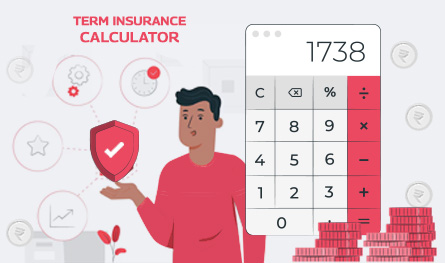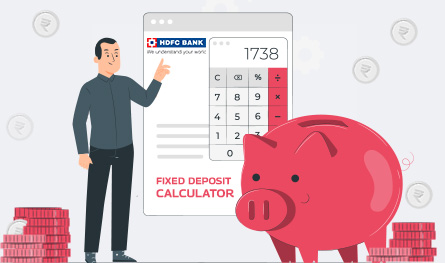Fixed Deposit for INR 50,000 for 1, 3, and 5 Years – Check Interest Rates and Maturity Amount
.png)
For many risk-averse Indian citizens, an FD account is the safest and the most reliable means of securing a lump sum amount in a couple of years. An FD account in a bank offering a good interest rate has succeeded in tempting people with the safety of their money and assured returns at maturity. In this post, let us check the ROI and maturity of 50,000 rupees FD for various term periods.
.png)
If you consider investment schemes, Fixed Deposits are extremely popular among investors in India. Being a safe option, it is also the most preferred investment that lets you save money. Let us understand an FD of 50k in rupees in detail here.
What is a Fixed Deposit (FD) Scheme?
When an investor deposits a lump sum of money in a bank or an NBFC for a fixed period at a fixed deposit interest rate, it is called an FD scheme. The investor receives an enhanced sum with the compound interest at FD maturity.
50,000 Fixed Deposit for 1, 3 and 5 years
1. INR 50,000 FD for a 1-year tenure
The return you receive, or the rate of interest that you can earn from a 1-year FD of INR 50,000, may vary from one bank to another. Also, there are other factors, like the age of the investor, on which the FD interest rates depend.
For instance, in the case of ordinary citizens, the ROI of FD is comparatively low. Alternatively, it is high in the case of senior citizens. So, depending on your age, you will receive a low or high FD interest rate on your INR 50,000 for a year. However, this difference in rate is minor.
| Banks | FD Rates for Normal Citizens (Per Annum) | FD rates Senior Citizens (Per Annum) |
| ESAF Small Finance Bank FD | 5.50% | 6.00% |
| Kerala Transport Development Finance Corporation Limited (KTDC) FD | 7.00% | 7.25% |
| Utkarsh Small Finance Bank FD | 7.50% | 8.25% |
| Fincare Small Finance Bank FD | 7.25% | 7.75% |
| Punjab and Sind Bank FD | 6.25% | 6.75% |
| Repco Bank FD | 6.75% | 7.25% |
2. INR 50,000 FD for 1 year in State Bank of India (SBI)
it comes to the most noteworthy banks in India, the State Bank of India is considered at the top. If you are planning to open an FD account with INR 50,000 for a year, the State Bank of India Fixed Deposit is the best option. With an annual interest rate of 6.75%, you will earn a decent return on your SBI FD of INR 50,000 for 1 year.
However, despite finding a suitable interest rate in your bank, looking for other viable options is suggested. This you can do by comparing similar FDs offered by different banks. You can use an FD calculator to compare interest rates to pick the best FD for 1-year. If you research well, you may find a better FD at a better interest rate than the one you plan to opt for. So, it is better to use the SBI Fixed Deposit monthly interest calculator.
3. INR 50,000 FD for 3 years
An FD can be either short or long-term, depending on the need/purpose of the investor for investing the amount. For long-term goals like children’s higher education, marriage, retirement planning, etc., an INR 50,000 FD for 5 years or so is ideal. But if you want to meet your short-term goals, like car purchase, vacation abroad, etc., 3 years FD will suit you best.
The table below discusses the interest rate provided by banks for three years:
| Banks | Tenure of FD | Interest rate (% annual) |
| DCB Bank Limited | 3 Year | 7.50 |
| Bandhan Bank Limited | 3 Year | 7.00 |
| Deutsche Bank | 3 Year | 7.00 |
| City Union Bank Limited | 3 Year | 7.00 |
| Yes Bank | 3 Year | 6.75 |
| IndusInd Bank | 3 Year | 6.75 |
| Union Bank of India | 3 Year | 6.70 |
| Corporation Bank | 3 Year | 6.70 |
| Andhra Bank | 3 Year | 6.70 |
| IDFC First Bank | 3 Year | 6.50 |
| Syndicate Bank | 3 Year | 6.50 |
| Canara Bank | 3 Year | 6.50 |
| Kotak Mahindra Bank Limited | 3 Year | 6.25 |
| Oriental Bank of Commerce | 3 Year | 6.25 |
| United Bank of India | 3 Year | 6.25 |
| Laxmi Vilas Bank | 3 Year | 6.25 |
| Punjab National Bank | 3 Year | 6.25 |
| HDFC Bank | 3 Year | 6.25 |
4. INR 50,000 FD for 5 years in SBI
A 5 years FD of INR 50,000 in SBI is a good option for investment planning. This investment would suit those who are looking at medium-term investments. With a present interest rate of SBI at 6.75%, investors are likely to earn INR 21,768 at maturity, making the total returns earned INR 71,768 on your INR 50,000 SBI 5 years FD interest rate. You can use the SBI interest calculator to find the accurate returns you can make from SBI FD.
However, it is still very important to compare the interest rates of different banks with your preferred bank to make an informed decision.
For instance, if a bank or an NBFC offers a higher interest rate and is a credible financial institution, it is better to open an FD account in that bank or NBFC.
5. INR 50,000 FD for 5 years in the Post Office
An FD account in the Post office has been there for a long time now. People prefer post office FD as it is reliable and has government backing. Hence, it is considered one of the safest ways to increase your money with considerable returns at maturity. If you consider investing 50,000 rupees in a post office FD account for 5 years, you may expect a return at the interest rate of 7% per year. Also, in the post office, the interest rate remains the same for everyone, be it a normal Indian citizen or a senior citizen. You can use a calculator to evaluate the post office’s 1-year FD interest rate.
6. INR 50,000 FD for 1, 3, and 5 years in Post Office
| Investment | Tenure | Maturity |
| INR 50,000 | 1 | INR 53,402 |
| INR 50,000 | 2 | INR 57,262 |
| INR 50,000 | 3 | INR 61,463 |
| INR 50,000 | 4 | INR 66,103 |
| INR 50,000 | 5 | INR 70,881 |

Author Bio
Paybima Team
Paybima is an Indian insurance aggregator on a mission to make insurance simple for people. Paybima is the Digital arm of the already established and trusted Mahindra Insurance Brokers Ltd., a reputed name in the insurance broking industry with 17 years of experience. Paybima promises you the easy-to-access online platform to buy insurance policies, and also extend their unrelented assistance with all your policy related queries and services.
Other Life Insurance Products
Latest Post

Let’s be honest – life insurance planning isn’t exactly someone’s weekend hobby. It is the financial equivalent of flossing: we understand its importance, but we tend to put it off. But somewhere between balancing work and life, you might realise you need to have a solid plan in place – just in case.


Ever tried planning your finances with a vague idea and a hopeful prayer? We have all been there scribing numbers on paper, trying to figure out if our savings will magically grow while we binge watch Netflix. The good news? There’s a smart way to do it. HDFC FD calculator is a nifty online tool that assists in figuring out exactly how much your fixed deposit will earn over time, without needing a math degree or your financial advisor on speed dial. Whether you are saving your money for an overseas vacation, your dream wedding, or just a future where your bank balances do not give you anxiety, this online calculator can help you make better- educated decisions.


If you’re planning to choose between a term life and a whole life insurance, this task is going to be tough. As Indians, we don’t generally understand the importance of life insurance coverage. Even if we do, the countless choices in the Indian insurance landscape end up overwhelming. However, an effective choice will depend on a range of factors. Your specific goals will highly affect what you pick for yourself.
Furthermore, both these plans can also largely vary depending on how much you wish to spend on an insurance plan. Besides goals, targets and the cost aspect, other factors will have to be taken into consideration before you can make the right choice about your preferred plan. If you are someone who wishes to opt for insurance plans sooner or later, this blog might help you out.


The heart is the most vital organ of the body and it is crucial to keep it in good condition to help our body function well. Every year, on the occasion of World Heart Day, emphasis is given to enhancing awareness of heart health and how we can prevent cardiovascular diseases by following certain heart-healthy measures. Read on to know more.


.png)
